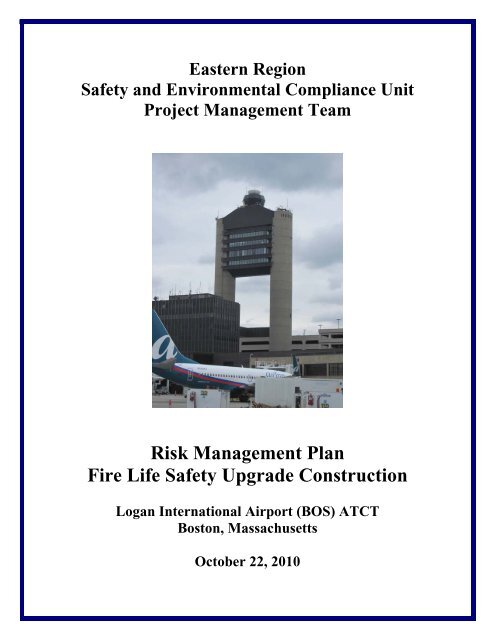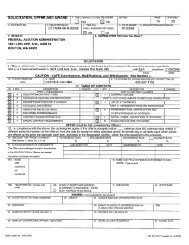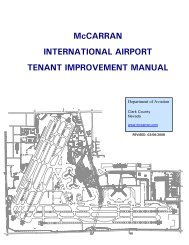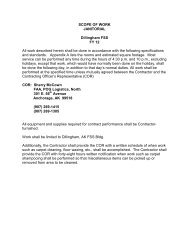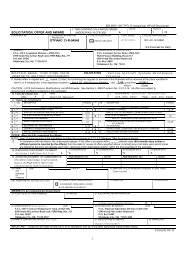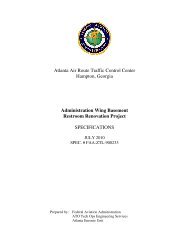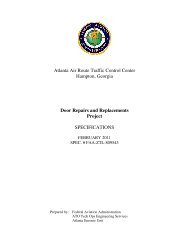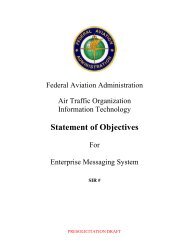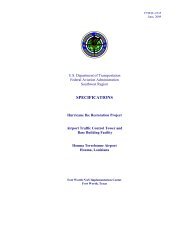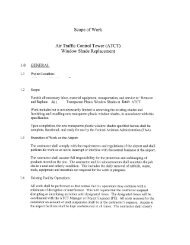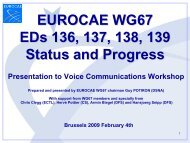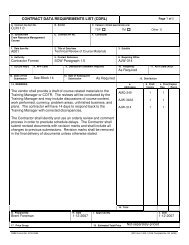Risk Management Plan - FAACO - Federal Aviation Administration ...
Risk Management Plan - FAACO - Federal Aviation Administration ...
Risk Management Plan - FAACO - Federal Aviation Administration ...
Create successful ePaper yourself
Turn your PDF publications into a flip-book with our unique Google optimized e-Paper software.
Eastern Region<br />
Safety and Environmental Compliance Unit<br />
Project <strong>Management</strong> Team<br />
<strong>Risk</strong> <strong>Management</strong> <strong>Plan</strong><br />
Fire Life Safety Upgrade Construction<br />
Logan International Airport (BOS) ATCT<br />
Boston, Massachusetts<br />
October 22, 2010
Table of Contents<br />
1.0 Executive Summary.................................................................................................<br />
1.1 Manageable <strong>Risk</strong>s ......................................................................................................<br />
1.2 Threatening <strong>Risk</strong>s ......................................................................................................<br />
1.3 Serious <strong>Risk</strong>s..............................................................................................................<br />
2.0 Scope of Work ..........................................................................................................<br />
3.0 <strong>Risk</strong> Assessment .......................................................................................................<br />
3.1 Communication..........................................................................................................<br />
3.2 Air Traffic Operations................................................................................................<br />
3.3 NAS Operations.........................................................................................................<br />
3.4 Project Schedule.........................................................................................................<br />
3.5 Facility Security.........................................................................................................<br />
3.6 Health and Safety of FAA and Contractor Personnel................................................<br />
4.0 Project-Specific <strong>Risk</strong> Assessment ...........................................................................<br />
4.1 Fall Protection and Ladder Safety..............................................................................<br />
4.2 Chemical Odors .........................................................................................................<br />
4.3 Critical Power Systems..............................................................................................<br />
4.4 Hazardous Materials ..................................................................................................<br />
4.5 Emergency Procedures...............................................................................................<br />
4.6 Lockout/Tagout..........................................................................................................<br />
5.0 Organizational Approval.........................................................................................<br />
Attachments<br />
Attachment 1 Project Contract List ...................................................................................<br />
Appendices<br />
Appendix A Alternate Standard for Fire Safety in ATCTs ..........................................<br />
2
1.0 EXECUTIVE SUMMARY<br />
This facility-specific <strong>Risk</strong> <strong>Management</strong> <strong>Plan</strong> has been developed for the Fire Life Safety<br />
Upgrade construction project at the Logan International Airport (BOS) ATCT. The<br />
review provides for consideration of the scope of work at the facility with associated risks<br />
to provide for a means of analysis to assess areas of impact and identify methods to<br />
reduce or eliminate risk associated with:<br />
• Communication<br />
• Air Traffic Operations<br />
• NAS Systems Operations<br />
• Project Schedule<br />
• Facility Security<br />
• Health and Safety of FAA and Contractor Personnel<br />
<strong>Risk</strong> management focuses on potential obstacles to successfully achieving project goals<br />
and objectives in terms of scope, schedule, budget, safety, and quality. <strong>Risk</strong> <strong>Management</strong><br />
is comprised of two essential components: risk assessment and risk mitigation. <strong>Risk</strong><br />
assessment is the effort to foresee risks, identify the possibility of unsatisfactory<br />
conditions occurring, and document risk factors for use in mitigation. <strong>Risk</strong> mitigation is<br />
the formulation of strategies and activities to avoid or lessen a specific risk or prescribe<br />
alternative courses of action in the case of unplanned event occurrence (contingency<br />
planning). These two components enable the project to meet goals and objectives even<br />
when less than optimum conditions are encountered.<br />
<strong>Risk</strong>s in this transition plan have been identified in the elements listed above. <strong>Risk</strong>s are<br />
evaluated for impact and severity, which are further used to determine a risk exposure<br />
assessment. The first category, impact, relates to the severity of the effect on the project<br />
if the risk manifests itself and is rated high, medium or low. The second category,<br />
probability, relates to the likelihood that the risk area will become a problem and is also<br />
rated as high, medium or low. <strong>Risk</strong> exposure is rated as serious, threatening or<br />
manageable and is determined based on the following table.<br />
<strong>Risk</strong> Exposure<br />
Probability<br />
High Medium Low<br />
High Serious Threatening Threatening<br />
Impact Medium Threatening Threatening Threatening<br />
Low Manageable Manageable Manageable<br />
From FAA STD 036C<br />
1.1 Manageable <strong>Risk</strong>s<br />
This risk exposure status means that all objectives are probable with normal planned<br />
execution of project activities. This category is assigned when known risk factors are low<br />
and active mitigation efforts are not required. These issues should be monitored to ensure<br />
that schedule delays or other factors do not escalate them to a higher criticality level.<br />
3
1.2 Threatening <strong>Risk</strong>s<br />
This risk exposure status means that all objectives are probable with planned<br />
interventions to mitigate the risks that threaten project objectives. A mitigation strategy<br />
should be completed to develop approaches to avoid or lessen the consequences of the<br />
risk area.<br />
1.3 Serious <strong>Risk</strong>s<br />
This risk exposure status means that a project objective will not be met unless effective<br />
action is taken to reduce the risk or the objective is re-baselined. One or more of the risk<br />
factors have been assessed as having a high probability of occurring and having a high<br />
impact on the project goal. This risk category requires immediate coordinated decisions<br />
to reduce the project risk and to initiate contingency planning.<br />
2.0 SCOPE OF WORK<br />
• Upgrades to the existing fire alarm system.<br />
• Upgrades to the existing sprinkler system.<br />
• Upgrades to existing handrails in the Central Stair.<br />
• Upgrades to firestopping and fire resistance rated construction.<br />
• Installation of new fire extinguishers in selective areas.<br />
Construction is expected to take no longer than 120 working days. The <strong>Federal</strong> <strong>Aviation</strong><br />
<strong>Administration</strong> (FAA) shall serve as the government organization managing and<br />
contracting to a qualified prime contractor and qualified specialty sub-contractors, as<br />
appropriate. In addition, FAA will provide a qualified government Resident Engineer<br />
(RE)/Contracting Officer’s Technical Representative (COTR) to oversee construction.<br />
3.0 RISK ASSESSMENT<br />
The following is a list of recognizable risks and an evaluation of the risk factors for<br />
impact, probability, and exposure. The risk area and potential impacts are defined and<br />
followed by risk mitigation options.<br />
3.1 Communication<br />
It is imperative that proper communication occurs during the course of construction. Any<br />
issues must be properly upward reported through the local AT and SSC personnel to<br />
ensure that there are no impacts or delays to construction schedules.<br />
Impact: Low<br />
Probability: Low<br />
Exposure: Manageable<br />
4
In order to mitigate the risks of poor communication, the following steps have been<br />
taken:<br />
• A Project Contact List (Attachment One) will be generated and distributed to all<br />
personnel associated with the project. The list will contain administrative and nonadministrative<br />
hours telephone numbers for 24-hour access for key personnel.<br />
• Subcontractor schedules are required as part of the submittal process, and will be<br />
provided to AF and AT personnel upon receipt and as they are revised.<br />
• The specification requires weekly construction progress meetings on site and weekly<br />
reports from the prime contractor that must include updated construction schedules, a<br />
description of work performed the preceding week, a description of work to be<br />
completed during the next two weeks, address issues and proposed solutions, and<br />
proposed system commissioning and test schedules.<br />
• The RE will maintain a daily construction diary and submit weekly reports to the<br />
FAA personnel and the PMT office. If an issue arises that requires immediate<br />
attention, proper communication with the CO, the Project Manager and the FAA LPE<br />
will occur.<br />
• When work is performed during shifts other than days, the RE will provide a written<br />
report at the end of each shift. The report will be left at a location mutually agreeable<br />
to AF and AT personnel, and will contain information about what was performed<br />
during the shift and what is planned for the next shift.<br />
• Teleconferences will be held as requested by AF and AT personnel, and will include<br />
AT personnel, SSC personnel, FAA personnel, the RE, the project superintendent,<br />
and the FAA LPE.<br />
3.2 Air Traffic Operations<br />
Minimal impacts to Air Traffic are anticipated during the construction project. Impacts<br />
to occupants or disruption of work will not be tolerated and may result in schedule<br />
delays, evacuation of the ATCT and termination of the contract.<br />
Impact: Low<br />
Probability: Low<br />
Exposure: Manageable<br />
The following steps have been taken to mitigate ATCT impacts:<br />
• A thirty day notice of construction will be provided; a Briefing Statement will be<br />
electronically submitted to the ATM for inclusion in the “Read and Initial” binder so<br />
that all staff members are aware of the scope of work and schedule.<br />
• Project briefings will be made available to Air Traffic personnel prior to the<br />
commencement of construction.<br />
• Engineering controls for dust and fumes will be utilized throughout the project.<br />
• Proper communication with AT personnel will be provided for as outlined in Section<br />
4.2.<br />
5
• All work in the Cab and other sensitive areas of the facility will be performed at<br />
night; the ATM will provide input relative to shifts at the Pre-Construction Meeting.<br />
3.3 NAS Systems Operations<br />
Impacts to NAS systems are not anticipated during the course of construction; any<br />
impacts may result in schedule delays or termination of the project.<br />
Impact: Low<br />
Probability: Low<br />
Exposure: Manageable<br />
The following steps have been taken to mitigate impacts to NAS Systems:<br />
• Work in AF-sensitive areas will be coordinated with AF prior to being performed.<br />
3.4 Project Schedule<br />
Schedule delays may affect AF, AT and NAS System operations but are not anticipated.<br />
Impact: Low<br />
Probability: Low<br />
Exposure: Manageable<br />
Steps that have been taken to mitigate impacts to schedule follow:<br />
• The specification requires weekly construction reports from the prime contractor that<br />
must include updated construction schedules. Impacts may therefore be anticipated<br />
and proactive steps taken to avoid delays.<br />
3.5 Facility Security<br />
Security is of the utmost importance at the BOS ATCT; impacts to security cannot be<br />
tolerated.<br />
Impact: Low<br />
Probability: Low<br />
Exposure: Manageable<br />
The following measures have been taken to mitigate risk to facility security:<br />
• Prime and subcontractor personnel will have valid identification and must sign when<br />
entering and exiting the facility. During non-administrative hours, the RE will ensure<br />
that sign in and sign out will be accomplished.<br />
6
• The prime and subcontractor superintendents and other key personnel identified by<br />
the FAA will have a full background check and will be issued a blue contractor<br />
badge.<br />
3.6 Health and Safety of FAA and Subcontractor Personnel<br />
A negative environmental or health/safety impact is of great concern and could result in<br />
delays, facility shutdowns and impacts to the NAS.<br />
Impact: Low<br />
Probability: Low<br />
Exposure: Manageable<br />
• The contract requires submission of a health and safety plan from the contractor.<br />
• FAA Order 3900.60 will be followed. A job walk will be held during which facility<br />
procedures, potential hazards and program elements will be discussed. The FAA<br />
point of contact and a subcontractor representative will sign the associated checklist<br />
and the RE ensure that impacts will not be made.<br />
• Daily safety meetings will be conducted.<br />
• Any safety concern will be reported immediately to the RE, the CO, COTR and the<br />
FAA LPE.<br />
• Asbestos and lead-containing coatings have been noted at the facility and reports<br />
provided to the contractors. Impacts to asbestos and lead-containing coatings are not<br />
anticipated.<br />
• Work control plan documentation has been submitted to the Safety and<br />
Environmental Compliance Manager (SECM) for impacts to hazardous materials; a<br />
copy of the Work Permit will be posted at the facility until construction is complete.<br />
• A project-specific Hazard Communication <strong>Plan</strong> will be submitted to the SECM and<br />
appropriate AF and AT personnel.<br />
• Material Safety Data Sheets (MSDS) will be provided to AF and AT personnel and<br />
maintained at the site in a location agreed upon at the Pre-Construction Meeting.<br />
• No material will be brought on to the site without the approval of the RE, AF and AT<br />
representatives; MSDS must be provided for all materials.<br />
• Dust and fume mitigation measures are required of the contractor and will be<br />
submitted to appropriate personnel at the Pre-Construction Meeting.<br />
• Adherence to EPA and OSHA regulations, FAA Orders, regional policy, and state<br />
regulations is required, as identified by the contract.<br />
4.0 PROJECT-SPECIFIC RISK ASSESSMENT<br />
4.1 Construction at heights greater than eight feet creates a fall risk.<br />
Mitigation:<br />
• A safety plan, to include all OSHA elements, will be provided by the<br />
contractor. The safety plan will address both fall protection and ladder safety<br />
in addition to other OSHA elements.<br />
7
• The RE will supervise fall protection and ladder safety. If unsafe practices are<br />
noted work will be stopped.<br />
• Fall protection and ladder safety will be a subject discussed during the daily<br />
safety meeting.<br />
4.2 Painting and sealing of wall and floor penetrations creates a risk of chemical<br />
odors.<br />
Mitigation:<br />
• MSDS will be posted at the facility, at a location agreeable to FAA personnel,<br />
and provided to AF and AT personnel.<br />
• A facility specific Hazard Communication <strong>Plan</strong> will be provided to the<br />
SECM, RE and AF/AT personnel.<br />
• Work involving painting and sealing of penetrations will be performed during<br />
night shifts or at a time agreeable with AT.<br />
• Odor mitigation will be provided via use of fans.<br />
• AT personnel will be offered the opportunity to perform a “sniff” test, if<br />
requested, to ensure that odor will not create problems with controllers.<br />
• Prevention of chemical odors will be a subject discussed during the daily<br />
safety meeting.<br />
4.3 Disruption of critical power systems could create a risk of disruption to the<br />
National Air Space (NAS).<br />
Mitigation:<br />
• The contractor will be provided as-built drawings of the facility, to be<br />
maintained on site, to ensure an understanding of critical power systems<br />
contained within the facility.<br />
• A facility walk-through will be conducted immediately following the Pre-<br />
Construction Meeting; the RE and contractor will be made aware of all<br />
sensitive areas in the facility.<br />
• The contractor will perform work in sensitive areas only under the supervision<br />
of the RE.<br />
• FAA technicians will directly supervise all work at power panels and all<br />
terminations.<br />
• Critical power systems awareness will be a subject discussed during the daily<br />
safety meeting.<br />
4.4 Impacts to hazardous materials could create a risk of subcontractor and<br />
FAA employee health and possibly force evacuation of the facility.<br />
Mitigation:<br />
• All appropriate Work Control <strong>Plan</strong> documentation will be filed with the<br />
SECM and posted at the facility for the duration of the project.<br />
• The RE and contractor personnel have been provided with a list of asbestos<br />
and lead-containing materials contained within the facility. Impacts to<br />
exterior crash posts and interior fire doors are not anticipated.<br />
8
• A facility walk-through will be conducted immediately following the Pre-<br />
Construction Meeting; the RE and subcontractor will be made aware of the<br />
hazardous materials contained on the interior and exterior of the facility.<br />
• The RE will directly supervise all work and ensure that impacts to hazardous<br />
materials are not made.<br />
• Hazardous materials will be a subject discussed during the daily safety<br />
meeting.<br />
4.5 Emergency evacuation could create a risk to the health of RE and<br />
subcontractor personnel due to not being familiar with facility procedures.<br />
Mitigation:<br />
• Emergency and evacuation procedures will be discussed at the Pre-<br />
Construction Meeting to ensure that RE and subcontractor personnel are<br />
aware of facility-specific procedures.<br />
• A copy of the Occupant Emergency <strong>Plan</strong> (OEP) will be provided to the RE<br />
and the subcontract superintendent immediately following the Pre-<br />
Construction Meeting.<br />
• The contractor will provide a site-specific Health and Safety <strong>Plan</strong> containing<br />
emergency telephone numbers and directions to the nearest hospital. The RE<br />
will be provided with a copy of the Health and Safety plan and ensure that<br />
facility-specific procedures are followed in the event of an emergency.<br />
4.6 Failure to control hazardous energy could create a risk to the health of<br />
subcontractor and FAA employees in the facility.<br />
Mitigation:<br />
• FAA Lockout/Tagout procedures will be discussed at the Pre-Construction<br />
Meetings; written documentation will be provided to the RE and the<br />
subcontractor.<br />
• FAA Technicians will be present whenever control of hazardous energy is<br />
required to ensure that proper procedures are followed.<br />
9
5.0 ORGANIZATIONAL APPROVAL<br />
SMO / SSC<br />
AT<br />
Representative _________________________________ ____________<br />
Date<br />
SECM _________________________________ _____________<br />
Date<br />
MTS _________________________________ _____________<br />
Date<br />
SSC<br />
Manager _________________________________ _____________<br />
Date<br />
FAA<br />
LPE _________________________________ _____________<br />
Date<br />
FAA<br />
PM _________________________________ _____________<br />
Date<br />
FAA _________________________________ _____________<br />
CO<br />
Date<br />
FAA _________________________________ ______________<br />
COTR<br />
Date<br />
FAA _________________________________ ______________<br />
RE<br />
Date<br />
Massport _________________________________ ______________<br />
Date<br />
10
Attachment One<br />
Project Contact List<br />
Name Title Phone Numbers<br />
FAA LPE<br />
FAA PM<br />
FAA CO<br />
FAA COTR<br />
FAA RE<br />
Hughes Licensed Fire<br />
Protection Engineer<br />
SSC Manager<br />
SECM<br />
ATM<br />
Subcontractor Site<br />
Superintendent<br />
Massport Representatives<br />
11
Appendix A<br />
The Alternate Standard for Fire Safety in Airport Traffic Control Towers<br />
29 CFR 1960.20<br />
12
The Alternate Standard for Fire Safety<br />
In Airport Traffic Control Towers<br />
29 CFR 1960.20<br />
_______________________________________________________________________<br />
Whereas, the agreement contained herein will provide a<br />
level of protection for occupants of airport traffic control<br />
towers equivalent to that of egress standards under 29 CFR<br />
Part 1910; and<br />
Whereas, this agreement was reached in cooperation with<br />
employee and management representatives of the <strong>Federal</strong><br />
<strong>Aviation</strong> <strong>Administration</strong>, the office of the Secretary of<br />
Transportation, and the Occupational Safety and Health<br />
<strong>Administration</strong>;<br />
Therefore, in keeping with this agreement, we the<br />
undersigned have affixed our signatures to this Alternate<br />
Standard for Fire Safety in Airport Traffic Control Towers,<br />
29 CFR Part 1960.20, in Washington, D.C., on this the 6 th<br />
day of May, 1998.<br />
______________<br />
Mortimer L, Downey<br />
Deputy Secretary of<br />
Transportation<br />
____________________<br />
Jane E. Garvey<br />
FAA Administrator<br />
____________________<br />
Gregory R. Watchman<br />
Deputy Assistant Secretary<br />
Of Labor for Occupational<br />
Safety and Health<br />
13
IV. The Alternate Standard<br />
(a) Scope and Application. This standard applies to<br />
all <strong>Federal</strong>ly owned or operated ATCTs. It sets forth<br />
minimum requirements essential to providing a safe means of<br />
exit in case of fire and other emergencies.<br />
(b) Definitions.<br />
“Authorized Person” means an employee who has been<br />
specifically assigned by the employer to assure compliance<br />
with this standard.<br />
“Base Building” means a structure including links and<br />
vestibules which connects with the ATCT and which may house<br />
administrative personnel, Terminal Radar Approach Control<br />
(TRACON) or passenger-related functions.<br />
“Cab” means the primary operating space in the ATCT<br />
situated at a desired elevation above ground level and<br />
physically oriented relative to the primary runways, so as<br />
to obtain the best unobstructed view of the airport aircraft<br />
primary movement areas (taxiways, runways, and flight<br />
approaches and departures).<br />
“Class A Finish” means any material classified at<br />
twenty-five (25) or less on the flame spread test scale and<br />
450 or less on the smoke test scale described in 6-5.3.1 of<br />
NFPA-101.<br />
“Class B Finish” means any material classified at more<br />
than twenty-five but not more than seventy-five on the flame<br />
spread test and 450 or less on the smoke test scale<br />
described in 6-5.3.1 of the NFPA-101.<br />
“Emergency Action <strong>Plan</strong>” means a plan for a workplace,<br />
or parts thereof, describing what procedures the employer<br />
and employees must take to ensure employee safety from fire<br />
or other emergencies.<br />
“Emergency Exit Route” means the route that employees<br />
are directed to follow in the event they are required to<br />
evacuate the workplace or seek a designated refuge area.<br />
“Exit” means a portion of a means of egress which is<br />
separated from all other spaces of the structure by<br />
14
construction or equipment to provide a protected way of<br />
travel to the exit discharge.<br />
“Exit Access” means a portion of a means of egress<br />
which leads to an entrance to an exit.<br />
“Exit Discharge” means a portion of a means of egress<br />
between the termination of an exit and a public way.<br />
“Fire Resistive” means the ability of materials or<br />
assemblies of construction to withstand exposure under<br />
standard fire test conditions for a prescribed temperature<br />
and period of time without structural failure. Fire<br />
resistive construction is that type of construction in which<br />
the walls, partitions, and structural members are of<br />
noncombustible materials which will withstand exposure to<br />
fire for a specified period of time without structural<br />
failure.<br />
“Hazardous Areas” means rooms or areas that pose a<br />
degree of hazard greater than that normal to the general<br />
occupancy of the structure, such as those areas used for<br />
storage or use of combustibles or flammable, toxic, noxious,<br />
or corrosive materials, or use of heat-producing appliances.<br />
“High Hazard Areas” means areas in structures used for<br />
purposes that involve highly combustible, highly flammable,<br />
or explosive products or materials that are likely to burn<br />
with extreme rapidity, or that may produce flame, poisonous<br />
fumes or gasses, explosive or irritant hazards, including<br />
highly toxic or noxious alkalies and acids and liquids or<br />
chemicals; also those subject to explosion or spontaneous<br />
combustion, and uses that otherwise constitute a high fire<br />
hazard because of the form, character or volume of the<br />
material used.<br />
“Link” means a connecting passageway between at ATCT<br />
and a base building. Links are typically one occupied level<br />
in height with direct access to the exterior of the<br />
structure.<br />
“Means of Egress (Exit Routes)” means a continuous and<br />
unobstructed way of exit travel from any point in a building<br />
15
or structure to a public way and consists of three (3)<br />
separate and distinct parts: the way of exit access, the<br />
exit, and the way of exit discharge. A means of egress<br />
comprises the vertical and horizontal ways of travel and<br />
shall include intervening room spaces, doorways, hallways,<br />
corridors, passageways, balconies, ramps, stairs,<br />
enclosures, lobbies, escalators, horizontal exits, courts,<br />
and yards.<br />
“Noncombustible” means the materials or assemblies that<br />
can not burn. Noncombustible construction is that type of<br />
construction in which the walls, partitions, and structural<br />
members are of material which inherently can not burn but<br />
does not qualify as fire resistive construction (i.e., the<br />
construction does not qualify as fire resistive because<br />
unprotected structural members may be damaged by heat<br />
generated by a fire).<br />
“NFPA-101” means the 1997 code for safety to life from<br />
fire in buildings and structures.<br />
“Protected Noncombustible Construction” means a<br />
construction in which all bearing walls or bearing portions<br />
of walls, exterior or interior are of noncombustible<br />
materials having a fire resistance of at least one hour and<br />
are stable under fire conditions; roof and floor<br />
construction and their supports have one hour fire<br />
resistance, and stairways and other openings through floors<br />
are enclosed with partitions having one hour fire<br />
resistance.<br />
“Smoke Proof Enclosure” means a stair enclosure<br />
designed so that the movement into the smoke proof enclosure<br />
of products of combustion produced by a fire occurring in<br />
any part of the structure is limited.<br />
“Tower” means an enclosed, independent structure or<br />
portion of a building with elevated portions for support of<br />
equipment or occupied for observation, control, operation,<br />
signaling, or similar limited use and not open to the<br />
16
general public. An ATCT is a tower used for aircraft<br />
control and related activities.<br />
“Tower Occupant Load” means the total number of persons<br />
permitted to occupy a tower or portion thereof at any one<br />
time.<br />
“Type I Construction” means a construction whose<br />
structural members, including walls, columns, beams, floors,<br />
and roofs, are all of approved noncombustible or limitedcombustible<br />
materials and have fire resistance ratings in<br />
accordance with NFPA 220, Table 2, 443 or 332.<br />
“Type II Construction” means a construction not<br />
qualifying as Type I construction in which the structural<br />
members, including walls, columns, beams, floors and roofs,<br />
are of approved noncombustible or limited combustible<br />
materials and have fire resistance ratings in accordance<br />
with NFPA 220, Table 3, 222, 111, or 000.<br />
“Type IV Construction” means a construction in which<br />
exterior and interior walls and structural members that are<br />
portions of such walls are of approved noncombustible or<br />
limited-combustible materials. Other interior structural<br />
members, including columns, beams, arches, floors and roofs<br />
are of solid or laminated wood without concealed spaces and<br />
comply with the provisions of NFPA 330 Section 3-4.2 through<br />
3-4.6. In addition, structural members shall have fire<br />
resistance ratings not less than one hour.<br />
(C) Exit Route Compliance Alternatives.<br />
(1) General. Every ATCT facility shall be so<br />
constructed, arranged, equipped, maintained, and operated as<br />
to protect its occupants from fire, smoke, fumes, toxic<br />
emissions during the period of time reasonably necessary for<br />
escape from the building or structure in case of fire or<br />
other emergency. The FAA shall ensure that each ATCT where<br />
construction begins after January 2001, with a total<br />
occupant load of twenty-five (25) or more occupants, has two<br />
(2) separate exit routes which begin at the base of the cab<br />
and extend to ground level.<br />
17
(2)(i) Within one-hundred and eighty days (180) from<br />
the effective date of this standard, the FAA shall submit in<br />
writing a list of all ATCTs indicating the alternative<br />
selected from paragraph (c)(3) or whether a request for a<br />
variance will be made. (ii) For each ATCT for which a<br />
variance has been requested, written details, and rationale<br />
for the request must submitted within one year from the<br />
effective date of this standard.<br />
(3) Alternatives. The FAA shall ensure that<br />
compliance with the exit route requirements of this standard<br />
are achieved by using one of the following alternatives:<br />
(i) Alternative A. For each ATCT having a single<br />
exit route and a total occupant load of less than twentyfive<br />
(25) occupants, the following requirements must be met<br />
(within one year from the effective date of this standard):<br />
(A) The tower is not used for living or sleeping<br />
purposes;<br />
(B) The tower is of Type I, II or Type IV<br />
construction;<br />
(C) The interior finish of the tower is Class A or<br />
Class B;<br />
(D) There are no combustible materials in, or under<br />
the immediate vicinity of the tower, except for necessary<br />
furniture and office supplies; and<br />
(E) There are no high hazard areas in, or under the<br />
immediate vicinity of the tower.<br />
(ii) Alternative B. For each ATCT constructed before<br />
the Year 2001, having a single exit route and a total<br />
occupant load of twenty-five (25) or more must meet the<br />
following requirements (within one year from the effective<br />
date of this standard):<br />
(A) The tower shall be of protected noncombustible<br />
construction except as follows:<br />
(1) All high hazard areas are constructed in<br />
accordance with paragraph (j) of this standard.<br />
18
(2) All vertical shafts shall be constructed in<br />
accordance with paragraph (d) (3) of this standard.<br />
(3) Fully sprinklered towers are permitted to be<br />
constructed of noncombustible materials.<br />
(4) Protected noncombustible construction is not<br />
required for steel beams in the upper cab areas.<br />
(B) The single exit shall be protected by a smoke<br />
proof enclosure constructed in accordance with NFPA-101, and<br />
must have a two (2) hour fire resistance rating throughout<br />
the enclosure. Exception: Exterior walls where the<br />
horizontal distance to the nearest structure is more than<br />
ten (10) feet. Additionally, the exterior walls of a tower<br />
must have at least a one hour fire resistance rating<br />
extending a vertical distance of fifteen (15) feet from the<br />
roof of an adjoining base building (or terminal), unless<br />
such a roof has at least a one hour fire resistance rating.<br />
(C) The smoke proof enclosure shall extend from the<br />
top of the cab to the point where at least two (2) exits are<br />
available. Exception (1). A single exit is permitted for<br />
smoke proof enclosures which discharge directly outside the<br />
structure or to a public way. Exception (2). A single exit<br />
is permitted for those base buildings consisting of a single<br />
story above ground and having less than 350 square feet.<br />
(d) Structural Requirements.<br />
(1) Stairways. All stairways shall comply with 29 CFR<br />
1910.36, except that, stairways located in smoke proof<br />
enclosures may be not less than twenty-eight (28) inches<br />
wide when measured from handrail to handrail. Circular<br />
stairs are exempt from the requirements for stairs.<br />
(2) Interior Finishes. All interior finishes of ATCTs<br />
must comply with NFPA-101, 6-5 for Class A or Class B flame<br />
spread ratings. Carpet shall not be mounted on walls or<br />
ceilings.<br />
(2) Vertical Shafts Including Smoke Proof Enclosures.<br />
(i) All shafts in towers shall be enclosed with<br />
protected noncombustible materials in accordance with NFPA-<br />
19
101 requirements and with at least a two (2) hour fire<br />
resistive rating. All related material and construction<br />
shall have an equivalent fire resistive rating.<br />
(ii) Shafts for elevators shall conform to the<br />
requirements of the American Standard Safety Code for<br />
Elevators, Escalators, and Dumbwaiters (ANSI A17.1)<br />
(iii) Shaft openings must be constructed in accordance<br />
with FNPA-101, 6-2.4.<br />
(4) Fire Walls, Partitions, and Fire Stops. Must be<br />
constructed and used in accordance with NFPA-101, 6-2.<br />
(e) Fire Detection and Alarm Systems. Each ATCT must<br />
be provided with a fire detection and alarm system in<br />
accordance with 29 CFR 1910.164 and 1910.165.<br />
(f) Fire Suppression Equipment. Suitable fire<br />
suppression equipment must be available in accordance with<br />
29 CFR 1910.157. Extinguishers shall not be considered to<br />
be equivalent to an automatic sprinkler system for purposes<br />
of omitting the requirement for protected noncombustible<br />
construction required by this standard.<br />
(g) Compliance Program.<br />
(1) The FAA shall establish, within one hundred and<br />
eighty (180) days of the effective date of this standard, a<br />
written program describing the alternative selected from<br />
paragraph (c) above to be used to comply with this standard.<br />
(3) The written program shall include the following:<br />
(i) The alternative provisions selected for exit<br />
routes;<br />
(ii) A description of the worksite and the<br />
modifications to be made to comply with this provision;<br />
(iii)Engineering plans and studies used to determine<br />
methods selected for achieving compliance with this<br />
provision;<br />
(iv) A detailed schedule for implementation of the<br />
provisions; and<br />
(v) Other relevant information.<br />
20
(3) If the FAA has not achieved compliance with the<br />
selected exit route provision (one year from the effective<br />
date of this standard), the FAA shall then assess the<br />
effectiveness of the modifications already in place, and<br />
establish any additional measures to ensure that employees<br />
are provided equivalent protection until compliance can be<br />
achieved.<br />
(4) The written program shall be submitted upon<br />
request to the Assistant Secretary, and shall be available<br />
at the FAA for examination and copying by the Assistant<br />
Secretary, and affected employee or authorized employee<br />
representative.<br />
(5) The plans required by paragraph (g)(2) shall be<br />
revised and updated at least annually to reflect the current<br />
status of the program.<br />
(h) Emergency Action <strong>Plan</strong>.<br />
(1) Application. The FAA shall ensure that a written<br />
emergency action plan is developed within ninety (90) days<br />
of the effective date of this standard for every ATCT. This<br />
plan must cover those designated actions the FAA and its<br />
employees must take to ensure safety from fire and other<br />
emergencies. The plan shall be made in each facility in a<br />
location which is readily available for review and use by<br />
facility personnel.<br />
(2) Elements of the <strong>Plan</strong>. The plan shall include, at<br />
a minimum:<br />
(i) Emergency escape procedures and emergency exit<br />
route assignments;<br />
(ii) Procedures to be followed by employees who remain<br />
to operate critical facility operations before they<br />
evacuate;<br />
(iii)Procedures to account for all employees after<br />
emergency evacuation has been completed;<br />
(iv) Rescue and medical duties for those employees who<br />
are assigned to perform them;<br />
21
(v) The preferred means of reporting fires and other<br />
emergencies; and<br />
(vi) Names or regular job titles of persons or<br />
departments who can be contacted for further information or<br />
explanation of duties under the plan.<br />
(vii)A plan or diagram of designated emergency egress<br />
routes shall be posted in a place readily available to<br />
employees,<br />
(4) Training.<br />
(i) Before implementing the emergency action plan, the<br />
FAA shall designate and train a sufficient number of persons<br />
to assist in the safe and orderly emergency evacuation of<br />
employees.<br />
(ii) The FAA shall provide emergency action plan<br />
training for each employee within one hundred and eighty<br />
(180) days of the effective date of this standard and<br />
annually thereafter. Training must also be provided:<br />
(A) Whenever the employee’s responsibilities or<br />
designated actions under the plan change, and<br />
(B) Whenever the plan is changes.<br />
(4) Written <strong>Plan</strong> Availability.<br />
(i) The written plan shall be kept at an easily<br />
accessible location at the workplace and made available for<br />
employee review.<br />
(ii) The written plan shall be submitted upon request<br />
to the Assistant Secretary, and shall be available at the<br />
worksite for examination and copying by the Assistant<br />
Secretary, and ATCTs employees or authorized employee<br />
representatives.<br />
(I) Fire Prevention <strong>Plan</strong>.<br />
(1) Application. The fire prevention plan, at a<br />
minimum, shall include the following elements:<br />
(i) A list of the major workplace fire hazards, and<br />
their proper handling and storage procedures, potential<br />
sources of ignition and their control procedures, and the<br />
22
type of fire protection equipment or systems which can<br />
control a fire involving them;<br />
(ii) Job titles of personnel responsible for<br />
maintenance of equipment and system installed to prevent or<br />
control ignition or fires; and<br />
(iii)Job titles of personnel responsible for control of<br />
fuel source hazards.<br />
(iv) The written plan shall be kept in an easily<br />
accessible workplace location and available for employee<br />
review.<br />
(3) Housekeeping. The FAA shall control accumulations<br />
of flammable and combustible waste materials and residues so<br />
that procedures shall be included in the written fire<br />
prevention plan.<br />
(4) Training. The FAA shall provide fire prevention<br />
training within one hundred and eighty (180) days of the<br />
effective date of this standard and at least annually<br />
thereafter for all ATCT employees. At a minimum, the<br />
training must cover the fire hazards of the materials and<br />
processes to which employees are exposed.<br />
(j) High Hazard Areas. High hazard areas must be<br />
separated by enclosure or sectioning from the rest of the<br />
tower by fire resistive walls or partitions, ceilings, and<br />
floors. Openings in the separating construction shall be<br />
protected with fire doors and fire dampers having a fire<br />
resistive rating equivalent to the separation.<br />
(k) Fire Drills. The FAA shall establish a fire drill<br />
program for each ATCT and ensure that each ATCT employee<br />
participates, at least annually, in a fire drill.<br />
(l) Training Program.<br />
(i) The FAA shall provide each employee with training<br />
within one hundred and eighty days from the effective date<br />
of this standard, at the time of the employee’s initial<br />
assignment to the ATCT, and at least annually thereafter.<br />
(ii) The FAA shall assure that each employee is<br />
training in the following:<br />
23
(A) The content of this standard and its appendices;<br />
(B) The types of situations which could result in<br />
emergency evacuation;<br />
(C) The components of the emergency action plan as<br />
required by paragraph (h) of this standard.<br />
(iii)The FAA shall make readily available to all ATCT<br />
employees a copy of this standard and its appendices.<br />
(iv) The FAA shall provide, upon request, all materials<br />
relating to the employee information and training program to<br />
the Assistant Secretary.<br />
(m) Recordkeeping. The FAA shall establish and<br />
maintain an accurate record at each facility of the<br />
following:<br />
(1) Training Program. The FAA shall maintain for each<br />
employee a written record of all training provided in<br />
response to this standard.<br />
(2) Emergency Action <strong>Plan</strong>. The FAA shall maintain a<br />
written record of the emergency action plan and any<br />
modifications to the plan.<br />
(3) Fire Prevention <strong>Plan</strong>. The FAA shall maintain a<br />
written record of the fire prevention plan and any<br />
modifications to the plan.<br />
(4) Compliance <strong>Plan</strong>s. The FAA shall maintain a<br />
written record of all compliance plans relevant to abatement<br />
of emergency egress hazards.<br />
(n) Compliance Status and Abatement Certification.<br />
(1) Existing ATCT Construction. The FAA shall provide<br />
for each facility, and make available at the facility, a<br />
biannual update for all existing ATCTs including at least<br />
the following information:<br />
(i) The location of the ATCT, including mailing<br />
address;<br />
(ii) The name of the authorized person;<br />
(iii)Status of the abatement;<br />
(iv) Completion date; and<br />
24
(v) Request for a Petition for Modification of<br />
Abatement, if the required abatement date can not be<br />
achieved.<br />
(vi) Certification by the authorized person that<br />
abatement has been completed and that the ATCT is in<br />
compliance with this standard.<br />
(2) ATCT Towers Scheduled for Replacement. The FAA<br />
shall provide for each facility and make available to the<br />
Secretary a semi-annual update for all ATCTs scheduled for<br />
replacement with at least the following information:<br />
(i) The location and mailing address of the ATCT being<br />
replaced and the location of the replacement facility;<br />
(ii) The name of the authorized person;<br />
(iii)Any written interim procedures which will be<br />
followed during the replacement period;<br />
(iv) The date that the replacement facility will be<br />
operational;<br />
(v) The disposition of the facility replaced; and<br />
(vi) Certification by the authorized person that the<br />
replacement ATCT meets the requirements of this standard.<br />
(vii)Certification by the authorized person that the<br />
interim protective measures are in place for the ATCT being<br />
replaced.<br />
(o) Effective Dates. This standard shall become<br />
effective on July 1, 1998.<br />
(1) All towers where construction begins after January<br />
2001 and with twenty-five (25) or more occupants, must be<br />
constructed with two (2) separate means of egress;<br />
(2) Paragraph (c)(2)(i) compliance is required by<br />
January 1, 1999. Paragraph (c)(2)(ii)compliance is required<br />
by July 1, 1999.<br />
(3) Alternative A. Compliance is required (by July 1,<br />
1999); and<br />
(4) Alternative B. Compliance is required (by July 1,<br />
1999).<br />
25
(5) Written Compliance Program. Compliance with this<br />
paragraph is required by January 1, 1999.<br />
(6) Emergency Action <strong>Plan</strong>.<br />
(i) Written <strong>Plan</strong>. Compliance with this paragraph is<br />
required by October 1, 1998 for every ATCT.<br />
(ii) Training. Compliance with this paragraph is<br />
required by January 1, 1999 for every ATCT employee.<br />
(7) Fire Prevention <strong>Plan</strong>.<br />
(i) Written <strong>Plan</strong>. Compliance with this paragraph is<br />
required by October 1, 1998 for every ATCT.<br />
(ii) Training. Compliance with this section is<br />
required by January 1, 1999 for every ATCT employee.<br />
(8) Training Program. Compliance with this paragraph<br />
is required by January 1, 1999.<br />
26


